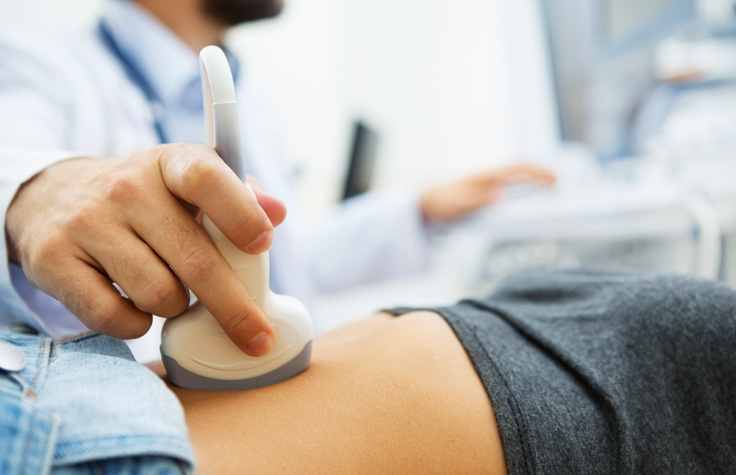NIPT vs Traditional Aneuploidy Screening Methods
NIPT and Aneuploidy Screening Accuracy
Traditional aneuploidy screening consists of maternal serum screening and ultrasound. These methods have an overall false positive rate of 5%.1,2 Follow-up diagnostic tests for a positive screening result may include an invasive procedure such as chorionic villus sampling or amniocentesis for karyotyping. These follow-up tests are more invasive than the initial screens and have associated risks.
As compared to traditional serum screening for common aneuploidies, NIPT has consistently demonstrated low false positive rates (higher specificity), and higher detection rate (higher sensitivity).3-5 In addition, NIPT can lead to 89% fewer unnecessary invasive tests as compared to traditional serum screening.6

Which screens provide the earliest results?
Noninvasive prenatal testing (NIPT) can be performed after just 10 weeks of gestation and requires only one maternal blood draw. Traditional screening is typically offered at 11—13 weeks, at the earliest; it involves a blood draw and ultrasound in the first trimester.6-7 The most accurate traditional serum screen methods (integrated or sequential screening) also include an additional blood draw in the second trimester, requiring multiple doctor visits.
Do all aneuploidy screens assess the same things?
Traditional aneuploidy screening typically provides a risk assessment for trisomies 21, 18, and sometimes, trisomy 13.
NIPT screens for the common autosomal aneuploidies (trisomies 21, 18, and 13). It can also screen for certain sex chromosome conditions (XO, XXX, XXY, and XYY) and determine the fetal sex (XX or XY).
Some NIPT blood tests include options to screen for other aneuploidies, such as rare autosomal trisomies, microdeletion syndromes, and whole-genome copy number variation (CNV).
What does NIPT implementation involve?
Aneuploidy screening with NIPT can be easy to implement in the lab. Illumina offers the VeriSeq NIPT Solution*, a next-generation sequencing (NGS)-based approach to NIPT. The solution provides software to guide the entire workflow from plasma isolation to library pooling, sample and batch tracking, and sample preparation kits are designed for use with an automated liquid handling instrument.
With the VeriSeq NIPT Solution, a single lab technician can prepare up to 96 maternal samples for sequencing in less than 8 hours, with only ~2 hours of hands-on time. The flexibility to run 24, 48, or 96 samples permits small sample batches, reducing regent costs and allowing your lab to scale up over time.
* For In Vitro Diagnostic Use. Contact an Illumina representative for regional availability.
Additional Resources
Interested in receiving newsletters, case studies, and information on new applications? Enter your email address.
References
- Practice Bulletin No. 163: Screening for Fetal Aneuploidy. Obstet Gynecol. 2016;127(5):979-981.
- Benn P, Borell A, Chiu R, et al. Position statement from the Aneuploidy Screening Committee on behalf of the Board of the International Society for Prenatal Diagnosis. Prenat Diagn., 2013;33:622-629. doi: 10.1002/pd.4139.
- Gil MM, Accurti V, Santacruz B, Plana MN, Nicolaides KH. Analysis of cell-free DNA in maternal blood in screening for fetal aneuploidies: updated meta-analysis. Ultrasound Obstet Gynecol. 2017 Apr 11. doi: 10.1002/uog.17484
- Chen EZ, Chiu RW, Sun H, Akolekar R, Chan KC, Leung TY, Jiang P, Zheng YW, Lun FM, Chan LY, Jin Y, Go AT, Lau ET, To WW, Leung WC, Tang RY, Au-Yeung SK, Lam H, Kung YY, Zhang X, van Vugt JM, Minekawa R, Tang MH, Wang J, Oudejans CB, Lau TK, Nicolaides KH, Lo YM. Noninvasive prenatal diagnosis of fetal trisomy 18 and trisomy 13 by maternal plasma DNA sequencing. PLoS One 2011; 6: e21791.
- Gregg AR, Skotko BG, Benkendorf JL, et al. Noninvasive prenatal screening for fetal aneuploidy, 2016 update: a position statement of the American College of Medical Genetics and Genomics. Genet Med. 2016;18(10):1056-1065.
- Bianchi DW, Parker RL, Wentworth J, et al. CARE Study Group: DNA sequencing versus standard prenatal aneuploidy screening. N Engl J Med. 2014;370:799-808.
- Bianchi DW, Platt LD, Goldberg JD, Abuhamad AZ, Sehnert AJ, Rava RP. Genome-wide fetal aneuploidy detection by maternal plasma DNA sequencing. Obstet Gynecol. 2012;119(5):890-901.


